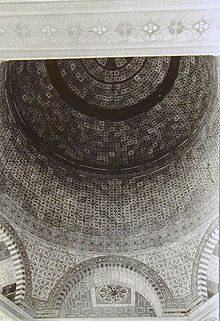- Dome of the Chain
-
 The Dome of the Chain is located in front of the entrance to the Dome of the Rock
The Dome of the Chain is located in front of the entrance to the Dome of the Rock
Dome of the Chain (Arabic: قبة السلسلة, Qubbat al-Silsila) is a free-standing dome located adjacently east of the Dome of the Rock in the Old City of Jerusalem. One of the oldest structures on the Haram ash-Sharif (Temple Mount), it is not a mosque or shrine, but is used as a prayer house.[1] It was built by the Ummayads, became a Christian chapel under the Crusaders, restored as an Islamic prayer house by the Ayyubids and has been renovated by the Mamluks, Ottomans and the Palestinian-based waqf.
Contents
History
Some structures within the dome date to pre-Islamic times,[2] but it is widely accepted by both Arab and Western scholars that the Dome of the Chain was originally built during the Ummayad-era of rule in Palestine, by the caliph Abd al-Malik in 691.[1][3] The Ummayad design of the building has largely remained unaltered by later restorations.[2] In addition to being a prayer house, the dome was used as a treasury for the local Muslim community.[4]
When the Crusaders invaded the Levant in 1099, they identified the dome as the spot where Saint James was martyred and transformed the building into a chapel dedicated to him. In 1187, the building was returned to Islamic use after Saladin recaptured Jerusalem for the Muslims. In 1199 the ceiling and pavings were renewed and marble was added to the columns by the ruling Ayyubids.[2]
The Crusaders briefly re-used the place from 1240-1244, but they were defeated by the Mamluks. The Mamluk sultan Baibars renovated it and slightly reduced the number of columns in the 13th century, as well as refacing the mihrab with marble. In 1561, under the Ottoman sultan Suleiman the Magnificent, the tiles of the mihrab were glazed and later in 1760, more tiles were added to it.[2]
The last major renovation was undertaken by the Islamic waqf of Jerusalem in 1975-76.[2]
Religious significance
The Dome of the Chain owes its name to an ancient legend during King Solomon's rule. According to Mujadir ad-Din,
Among the wonders of the Holy House is the chain, which Solomon, son of David, suspended between Heaven and Earth, to the east of the Rock, where the Dome of the Chain now stands. The chain had one characteristic. If two men approached it to solve a point of litigation, only the honest and upright man could take hold of it; the unjust man saw it move out of his reach.[4]
The building in Islamic tradition is the spot where Judgment Day will occur in the "end of days" and where a chain will stop the sinful and let the just pass through. Notably, the mihrab in the al-Aqsa Mosque is located exactly in the middle of the qibla wall of the Temple Mount on north-south axis with the Dome of the Chain.[3]
Architecture
The Dome of the Chain's mihrab
The building consists of a domed hexagonal structure with open arches. The dome, consisting of an inner hexagonal drum, is made of timber and is supported by six columns, enclosed by a wall-less roof. The roof is situated atop of eleven columns supported by a polygonal outer arcade. The plan of the structure is a triangular base with two inter-columnar spaces of the inner drum which correspond to three of the outer polygons on the northeastern and northwestern sides. The qibla wall contains the mihrab or prayer niche and is flanked by two smaller columns.[2]
There are a total of seventeen columns in the structure, excluding the mihrab, versus the original amount which was twenty.[4] The Dome of the Chain has a diameter of 14 metres (46 ft), making it the third largest building on the Haram after the al-Aqsa Mosque and the Dome of the Rock.[3]
Dome of the Rock model
According to a number of early Arab historians, the Dome of the Chain (excluding its outer wall) was used as a model for the Dome of the Rock. Like the latter, the Dome of the Chain has two concentric polygons, with pillars bound together by a wooden beam and supporting arcades. The Dome of the Rock is three times the size of the Dome of the Chain and the ground plan and height are proportional.[5]
References
- ^ a b Al-Aqsa Guide: 31. Dome of the Chain (Silsilah) Al Aqsa Friends 2007.
- ^ a b c d e f Pringle, Deny. (1993). The Churches of the Crusader Kingdom of Jerusalem: A Corpus, Vol. III Cambridge University Press, pp.182-184.
- ^ a b c Dome of the Chain Archnet Digital Library.
- ^ a b c Murphy-O'Connor, Jerome. (2008). The Holy Land: An Oxford Archaeological Guide from Earliest Times to 1700 Oxford University Press, p.97. ISBN 0199236666.
- ^ Conder, Claude Reignier and Palestine Exploration Fund. (1887). Tent Work in Palestine: A Record of Discovery and Adventure R. Bentley & Son, 165.
Islamic structures on the Temple Mount Mosque 
Domes Dome of the Ascension • Dome of the Chain • Dome of al-Khidr • Dome of al-Khalili • Dome of Moses • Dome of the Muezzin • Dome of al-Nahawiyyah Dome of the Prophet • Dome of the Rock • Dome of Solomon • Dome of the Spirits • Dome of Yusuf • Dome of Yusuf AghaFountains Fountain of Ibrahim al-Rumi • Fountain of Qasim Pasha • Fountain of Qayt Bay • Fountain of Sha'lan • Fountain of Sultan Solomon • Pool of RaranjOther structures Islamic Museum • Mihrab Ali Pasha • Minbar of Buran al-DinMinarets See also Islamization of the Temple Mount • Jerusalem Islamic WaqfCoordinates: 31°46′41.00″N 35°14′08.94″E / 31.77806°N 35.2358167°E
Categories:- Temple Mount
- Islamic architecture
- Domes
- 690s architecture
- Islam in Jerusalem
- Arabic architecture
- Umayyad architecture
Wikimedia Foundation. 2010.


